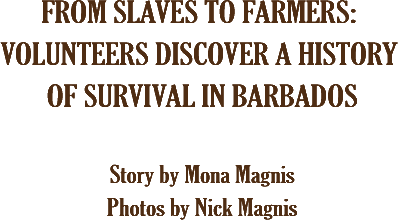
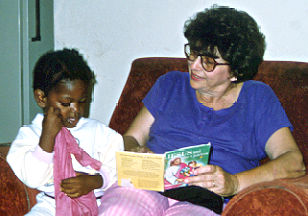
Miss Alice’s granddaughter and the author
An Earthwatch Institute Volunteer Vacation!
Atop Farley Hill on the Atlantic Coast of Barbados, there is a burned out hulk of a once magnificent sugar plantation manor house, a memorial to the majesty and misery that once prevailed in this island nation. It is only in our imaginations that we can feel the misery of the hundreds of thousand of Africans that were brought here as slaves to farm the sugar plantations, build the mansions and support the lifestyle of the British aristocracy that formerly ruled this land.
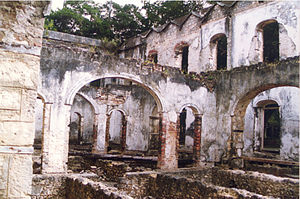
The former Manor House at Farley Hill
Bit by bit, this has all changed. The slaves were freed in the 1830s and cane gradually lost its economic pre-eminence. Barbados achieved independence in 1966 and ironically is now ruled by the descendants of the plantation slaves.
My husband, Nick, and I arrived in Barbados as part of an Earthwatch Institute volunteer expedition, assigned to look for the descendents of the former slaves who are still engaged in farming. Our research leader, Loran Cutsinger, was an ethnologist and professor at the University of Wisconsin. As a by-product of her earlier research work, Loran had become very knowledgeable about the issues facing small farmers.
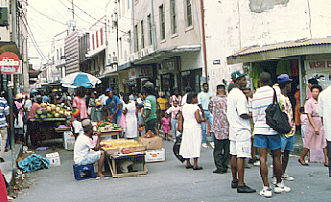
Bridgetown street hawkers
She spent two years with the Peace Corp and had written her doctoral dissertation on Barbadian “hawkers”. The hawkers, mainly women, engaged in selling the small farmer’s produce in shed markets built for this purpose in the capital city, Bridgetown, and in other smaller towns. In the intervening years the coming of supermarkets, for the most part, displaced the hawkers. Had the small farmers been affected in the same way, she wanted to know?
Our Earthwatch expedition was composed of two separate programs. One group, “the diggers”, was engaged in archaeological excavation of a Pre-Columbian Arawak encampment. We, “the walkers”, spent each day searching for and interviewing small farmers. Nick and I were still in our sixties then; the other members of our group were women in their forties and fifties.
Our Home Away From Home
Our base of operation was the Bellairs Research Institute of McGill University where we occupied a twin-bedded room with the barest of essentials. The bathroom was at the end of the hall and we shared it with a multitude of small creatures, none of them lethal. In fact, we became rather fond of our shower mates in time. A cook did all grocery shopping, prepared picnic lunches and a delicious dinner in the evening. We prepared our own breakfasts, each to our own taste. On weekends we reviewed and recorded our information, tended to personal errands, did laundry and became tourists walking and gawking as visitors like to do.
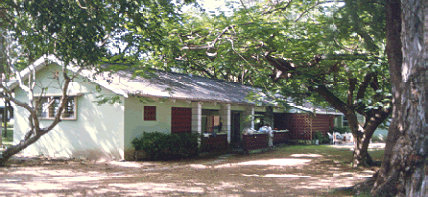
The Bellairs Institute
With only one vehicle for both programs and the dig too far for walking, we were left to our own devices. This meant we traveled by public bus to distant areas and then walked into the most remote areas. The sunny weather made the walks a pleasure, and I came home much healthier and fitter than when I left.
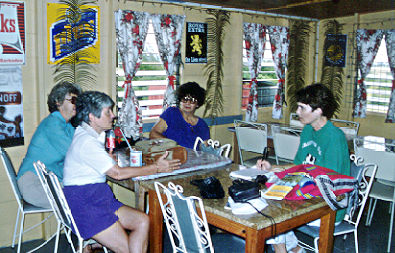
Back home for a discussion of the day’s work
Nick was the project’s official photographer, and I was in charge of recording the conversations and transcribing them into the computer. As the volunteers became more knowledgeable about the issues, each one began asking their own penetrating questions. With often-inscrutable accents, and in the case of several older subjects, few teeth which also interfered with comprehension, it was important for every member to pay close attention in the field. Lively review discussions at the end of the day brought everyone’s observations to the table.
On the Research Trail
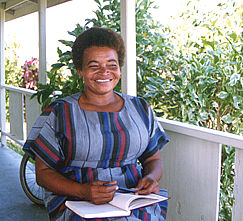
Miss Mary of St. Philips parish
Finding our quarry was a matter of making friends with the locals: our leader was expert in this area. We started with a visit to an agricultural specialist who, after a cordial greeting, some conversation about our task and a very welcome glass of iced tea, gave us an excellent list of people to contact. “Talk to Mary in St. Philips parish who has a problem with roaming livestock,” we were advised, “or to Miss Alice St. John in St. Lucy’s parish who is developing a banana plantation.”
Before we located the ladies, we found Mr. Colin Hudson who developed a method of utilizing trash truck tires. He uses them as utensils in which he grows produce. The tires are free, the bagasse (waste from sugar cane) is free, and poultry droppings for fertilizer are free. All he has to add are the plants or seeds and water. His methods have proven very productive and use no herbicides or fungicides.
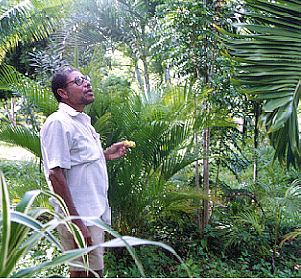
Mr. Cumberbatch proudly hosts a farm tour
Mr. Ed Cumberbatch greeted us with a beatific smile. He was a retired agricultural expert for the Barbados government and some international agencies, a very erudite and hospitable man. Half his four-acre farm is a nursery used for a landscaping venture and the other half is planted with tropical fruits for sale locally. He believes the production of tropical fruit is the best land investment that can be made for the farmers. Mr. Cumberbatch was happy to direct us to other farmers.
Mary, mother of two pre-teen daughters, has been farming a four-acre farm for eleven years. She faces two difficult problems every day. First is the nighttime theft of produce. Well organized thieves obtain a vehicle and enlist pickers. During the night, they raid a field and by morning the produce is sold. Several raids a week enrich the thieves and reduce Mary’s income significantly.
The second problem is roaming livestock invading her fields and destroying her crops. She impounds the livestock when she can and negotiates with the animal’s owner for compensation for her lost crops. There is not much she can do if the owner refuses to cooperate, but in spite of her losses she continues to farm her land with little help and a lot of hope.
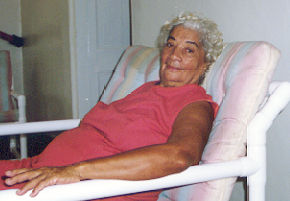
Miss Alice St. John
We were amazed at the vitality and enthusiasm of Miss Alice St. John, age 76. She manages 160-acre Foster Hill Plantation owned by her son who is a physician. When she took over, the plantation was used for pastureland; now it is being converted to banana and vegetable horticulture. This delightful senior citizen markets her produce directly to hotels and supermarkets.
An Intriguing Jewish Synagogue
On the first Friday of our expedition, a Jewish member of our team invited Nick and me to accompany her to services at the island’s sole synagogue. When we entered the synagogue, we felt that we had been transported into the interior of a beautiful Portuguese jewel box. At the end of the service, the president of the congregation welcomed us warmly, then told us the remarkable story of this synagogue.
In the early seventeenth century, 300 Portuguese Jews living in Recife, Brazil, escaped persecution by moving to Barbados. They were skilled in the sugar industry and taught the Barbados landowners everything they knew about the cultivation and production of sugar. In 1654 they created an architecturally celebrated synagogue which was destroyed by a hurricane in 1831 and subsequently rebuilt.
However, some time in the nineteenth century or early twentieth century the little colony left the island. No one seemed to know why or even where they went. The synagogue was abandoned and the religious items as well as hardware and other artifacts were sent to England for safekeeping.
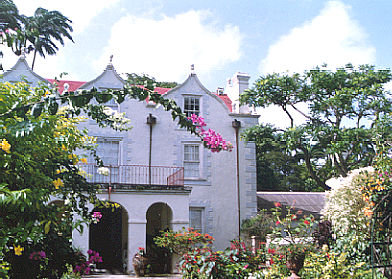
St. Nicholas Abbey, early plantation manor house, is open to the public.
The present Jews in Barbados are the descendants of Eastern European Jews who fled the Nazi terror in the 1930s. In 1983 they bought the old rundown building and began its restoration. They knew that many of the interior artifacts were stored in England but, when they asked for them to be returned, they were refused. Persevering nonetheless, they have restored the synagogue to its original beauty. Today it is considered one of the “Seven Wonders of Barbados” (www.barbados.org/7wonders.htm).
Our volunteer vacation was a conduit to service, adventure and self-discovery. Good health, stamina, flexibility, an open mind, and a sense of humor were the only skills required on this wonderful opportunity to experience Barbados as few tourists do. Age was never a consideration for Earthwatch, nor for us!
Follow Up Facts
Since 1971, Earthwatch Institute has organized unique volunteer vacations that allow people to work alongside leading scientists. Last year 4,300 volunteers joined over 130 field research expeditions around the globe, collecting data on climate change, endangered species, marine mammals and inspiring global and local action towards a sustainanble future. Baby Boomers and retirees have been a consistent resource as they return to Earthwatch for their annual working vacations, but Earthwatch is increasing popular among teens, teachers, and families as well. www.earthwatch.org.
Barbados Tourism: www.barbados.org
Barbados Travel Guide
This site offers plenty of great tips for people who are considering a visit to Barbados. Get detailed weather information, and pick the perfect Barbados hotel.
Vacation in Barbados
This friendly Barbados vacation guide provides visitors with helpful travel information on Barbados hotels, Barbados vacation villas and other tourist information.
Looking for other Volunteer Vacation Ideas?
 LEAD Adventures’ local specialists offer over 30 different volunteer and adventure travel programs in Ecuador for individuals or groups. Volunteer with us and experience Ecuador’s four worlds: Andes, Amazon, Coast, and Galapagos Islands! Consider our GAP for Grown Ups programs with added attention to luxuries and privacy older adults seek. www.lead-adventures.com.
LEAD Adventures’ local specialists offer over 30 different volunteer and adventure travel programs in Ecuador for individuals or groups. Volunteer with us and experience Ecuador’s four worlds: Andes, Amazon, Coast, and Galapagos Islands! Consider our GAP for Grown Ups programs with added attention to luxuries and privacy older adults seek. www.lead-adventures.com.
Volunteer feature articles in our web collection: Visit our richly-illustrated feature on “Volunteer Vacations Worldwide“, documenting a variety of well established opportunities involving physical and mental challenges, together with a huge dose of holiday satisfaction. Wild dolphin research in Hawaii, orphanage outreach in Peru and India, archaeological excavation in Mongolia, raptor rehabilitation in Alaska, teaching in the Cook Islands, and natural lands restoration in British Columbia, will surely set the motivational juices flowing!
Check out our latest volunteer vacation feature articles profiling an agricultural Global Service Corps assignment in Tanzania and the story of Global Volunteer Network and its visionary founder, Colin Salisbury. Or look in on a Global Citizens Network volunteer vacation lending a hand on native reservations in Arizona and New Mexico.
Over the past 30 years, Mona and Nick Magnis have traveled to more than 30 countries on five continents taking notes and photos. Mona has volunteered for six Earthwatch expeditions and Nick for eight. Other travels include 27 Elderhostel trips, a good deal of independent travel and a sprinkling of mainstream tours. Both life-long students, Mona earned her Master’s degree in Liberal Studies at age 64, and Nick earned his in his early 70’s. Mona’s adventurous travel stories have also been published by www.travellady.com.
Feel free to explore other stories about volunteer vacations well suited to senior travelers, their families and friends. Click on the titles below to read each inspiring article.
Volunteer to teach English in Crete
Organic farm and garden volunteer travel
Volunteer for wildlife in Africa
Giant pandas need our help
Volunteer at India tea estate
Hawaiian Islands volunteer vacations
Cheetah volunteer vacations
Older travelers love volunteering
Volunteering in Rural Tanzania
Monitoring the health of Australia’s Great Barrier Reef
US Native volunteer vacations
Volunteer vacations worldwide
